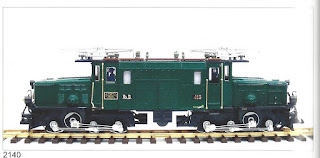Your Famous Klaus has had quite a few LGB crocodiles in his workshop over the years. Their owners love their engines wanting to have high quality sound and a good digital system in their Crocodiles.
The first LGB crocodile had the number 2040 which was earlier used by LGB for a 2-axle tender locomotive (see future LGB Yarner blog for more details). Details for the LGB 2040-1 are:
 |
| This 2040 hand model is from the 1979/80 catalog, page 32 |
This very first LGB crocodile # 2040 was announced as new item late 1978. But Gunter Ruhland, head mold master at LGB had his problems with the molds. To make a hand model for the catalog is one thing. To get the molds ready for serial production quite another. Mr. Ruhland had to figure out how to built the front and rear end hood mold without showing any division lines in the manufactured product. The finished mold was a masterpiece in molding technology in those days. It took about a year to come up with a satisfying solution that Wolfgang and Eberhard Richter found acceptable. Therefor the LGB fan and customer saw 1979 approaching and ending with just another announcement in the 1979/80 catalog for the LGB Crocodile to come into dealers stores. Then eventually in 1980 the wait was over and the new LGB crocodile was delivered to dealers and costumers alike.
It will be hard to find a 1978 LGB crocodile here in the USA. The US market was not exactly established yet and only very few German LGB locos made the transatlantic trip. Most crocodiles came over after 1989 when the San Diego LGB office was fully established and a growing number of USA LGB clubs began operating promoting the product with the hobby. By then, even in (Western) Germany the 1978 model was mostly not available anymore.
Color changes for the next 'models' were plenty and in short order. Starting with # 2040-2 Running rails changed to grey, isolators came in red, then grey or red and later, after 1993 in green, the jack shafts got stickers, the locomotive body was medium brown , then brown, then darker brown. handrails turned to yellow and head lights got golden rings.The numbers indicated color changes in these details, from 2040-2 to 2040-5 and then from 1993 on 20400-1, -2 and 20400-8 in 2001 with digital decoder. According to the Kompendium the first sales price was in Deutsche Mark 495.00 (in 1980) and the LGB Kompendium lists the 20400-2 for Euro 450.00 (US$ 500.00 in 1994). However Klaus got his first Crocodile in mid 1980 and paid DM 740.00 for her. The equivalent in todays $-value being a stunning $ 3500.00.
In 1990 LGB edited a specialty series crocodile in green, LGB # 2140, for DM 895.00 (US$ equivalent in 1990 was $ 300.00 or US$ 585.00 today).
In 1993/94 a red crocodile followed with LGB# 22400 and a rather small edition of 2500.
LGB # 24402 was a blue crocodile offered in the 2001/2002 catalog as a specialty limited edition series of 1,000 titled 'collectors edition'. The price had been upped to DM 1695.00 or roughly US$ 850.00. LGB 24402.8 had the added digital decoder.
In 2003-2004 a dark brown Crocodile followed with # LGB 25402 with yellow handrails and silver colored pantographs and green isolators. It was offered under the eXtra program which offered dealers a somewhat clumsy alternative to the regular ordering with a pretty high price range for actually not-so-special LGB stock. List price was Euro 999.00 or US$ 1,250.00.
The last crocodile - again in blue - under the old original LGB was the LGB# 27402 "Glacier express/ 75/ 1930-2005/ St.Moritz/Davos-Zermatt" from 2005 to 2007. The price was a dizzying Euro 1,034.00 or US$ 1,350.00 ( today about $1,700.00)) with the closing of the LGB factory right around the corner.
In 1999/2000 LGB issued the # 70640 ; the collector's edition set "Alpine Classic RhB" with a classic brown loco and 2 long passenger cars # 34650 in a pretty blue - beige coloring. The edition was limited at 1,500 for a price of DM 2,698.00 or about US$ 1450.00 (present day $ 2,220). A value that the current market does not accept. The pre-owned market of Spring 2019 ranges from $ 750.00 to $ 1,700.00 for the set with little demand for it on the eBay platform. However, pre-owned LGB stock dealers show their crocodiles moving fast,
The new LGB under Maerklin issued two more crocodiles until 2010 (YT didn't follow the product lineage of new LGB after 2009) with #s: 20405 and 22405.












